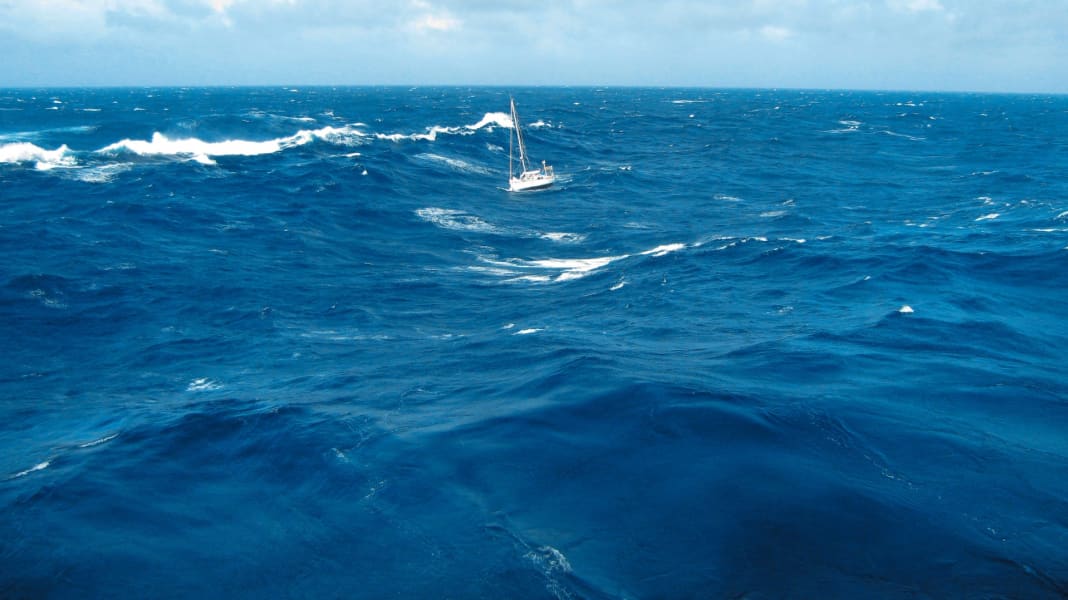
Whether it's the Golden Globe, Atlantic Rally for Cruisers or solo long-distance sailing, more and more sailors have recently been in distress in the middle of the ocean. However, anyone who suffers a broken mast, falls seriously ill or is in danger of sinking far from shore cannot simply be rescued by the coastguard or sea rescuers. Then the big players often have to help: Tankers or container ships, whose crews rescue the casualties with daring manoeuvres in often stormy seas and tiny lifeboats.
You often read the reports of rescued sailors later, including in YACHT. But how do those who abseil down from great heights in a tiny boat fare? And the captains, who often jeopardise the health and lives of their crew?
Captain Jan Rüsch has experienced it. In the North Atlantic, his crew rescued a Belgian sailor from his leaking eleven-metre yacht. The manoeuvre took place several years ago, but it still moves Rüsch, who is a sailor himself, to this day. He reports on the difficulties and dangers of such a rescue operation and provides a rare view of the event from the bridge of a commercial vessel.
YACHT: Mr Rüsch, how did it come about that you had to rescue the sailor?
Jan Rüsch: On a Friday morning, we received a very general Navtex message to all ships in the sea area. They were asked to keep a sharp lookout for a white sailing boat on its way from Halifax to Belgium. The information was very vague and the weather conditions were extremely bad. We had storms with eight metre high waves and rain for days. I thought we would almost have to sail round it before we saw it. We kept a lookout but didn't spot anything. In the afternoon, however, a US Coast Guard search aircraft found it and radioed us specifically for help. The sailor was 450 miles away from Cape Cod and therefore out of range of a helicopter that could have picked him up.
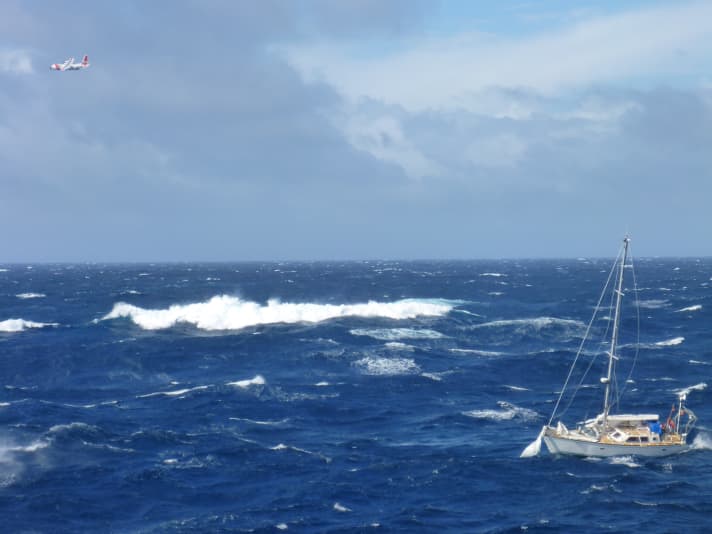
What had happened on the sailing boat?
The single-handed sailor wanted to contact a friend once a day by satellite phone. He did this once and told him that he was in bad weather and had water in the boat. When the next advised call did not come, the friend alerted the coastguard.
How difficult was it to find the sailor at the indicated position?
Very heavy. We couldn't spot it for a long time. Which is hardly surprising - a white boat that is only slightly larger than the whitecaps all around! If it had kept a sail, it would have been easier to see. By the time we spotted it, it was only a mile away and I was travelling far too fast at 18 knots! You don't just slow down a 336 metre ship weighing 130,000 tonnes. It takes three minutes just to shut down the engine. I could only slow the ship down by turning a circle around it. The rudder blade of a full container ship is bigger than a detached house. Set at 35 degrees, it's like a brake parachute.
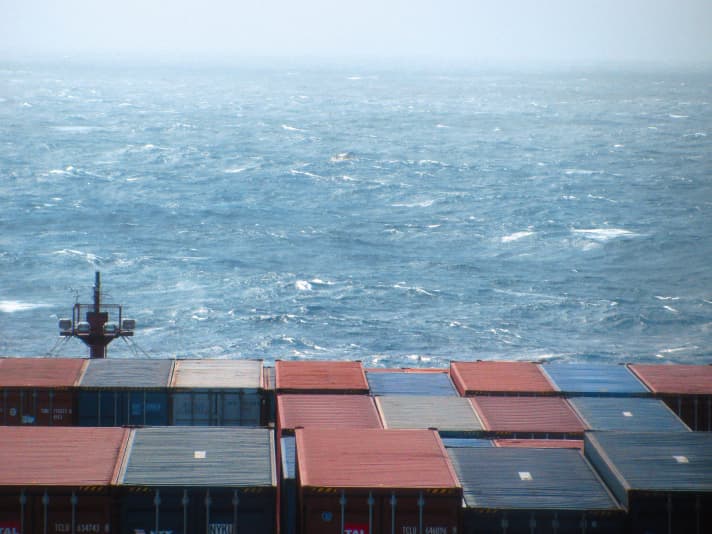
Didn't the shipwrecked vessel have a radio or AIS on board that would have made the search easier?
Yes, but as a result of the water ingress, all his electrics and electronics had been damaged - so he no longer had a radio. The search plane had already tried to throw him a buoyant walkie-talkie on a long line. But he couldn't catch it.
What condition were the sailor and his ship in?
We passed within 30 metres of him. I wanted to see up close whether it was really in distress. The boat looked desolate: The halyards were dragged, the sails were not secured and were floating in the water. He must have sailed into the bad weather without even reefing. He obviously hadn't secured anything, and that tore everything to shreds. Basically, he failed completely as a sailor. What puzzled me was that he obviously felt in distress, but to me the boat had a normal trim. It didn't seem to be any deeper in the water than normal. I found this strange and felt a great resistance within me to risk the safety and lives of my people to save him. But he clearly signalled to us that he wanted to change boats.
So how exactly did the rescue take place?
We practise such manoeuvres regularly and proceeded according to a plan. First of all, we discussed the situation and considered how we could get to the distressed vessel. Our small open lifeboat with a 25 hp outboard motor is best suited for recovering. It hangs in the davit about 17 metres above the water. Three men climbed into the boat and then we lowered it. Lowering it into the water is a very critical moment, but once the boat is free of the ship, the rest is just a question of seaworthiness.
Wasn't it too stormy?
Basically, yes. But I could drive a duck pond. That's what captains call it when they round a bend in which the ship drifts outwards. The water then flows under the ship and comes up again downwind, giving you a very smooth sea surface. The lifeboat is placed in this duck pond and the hook is released. Then it sets off. However, something went wrong for us.
"I realised that if the rescue before dark didn't work and something happened, I wouldn't be able to find the crew again"
What happened?
Of course, you want to maintain communication between the ship and the lifeboat in such a dicey situation. That's why we have our own waterproof and buoyant walkie-talkies for such emergencies. The helmsman of the lifeboat was wearing one of these around his neck. However, after it had left the smooth water zone, the first wave showered the crew once - and the expensive and almost new walkie-talkie no longer worked. It was probably not waterproof after all.
That doesn't sound good!
More than that, in this situation it was a disaster! We no longer had any radio contact on the bridge - neither with the sailor nor with our people in the lifeboat.
But it still travelled on to the damaged vessel, didn't it?
Yes, but my people couldn't get very close to the boat. It was too dangerous because of all the lines floating in the water, which could have got caught in the propeller of the outboard motor. So the man had to jump into the water. He was wearing overalls, which was good, and an automatic waistcoat, which was also good. However, he was wearing the waistcoat under his overalls - it half strangled him when it inflated. My boys then pulled him out of the water, three of them on one side of the boat over the edge. I was afraid on my bridge that the boat would capsize. When the sailor was on board, one of my men took a knife and pierced his lifejacket so he could breathe again. With binoculars from 300 metres away, it looked like he was going to stab him. If you'd had a radio, you could at least have asked what was happening.
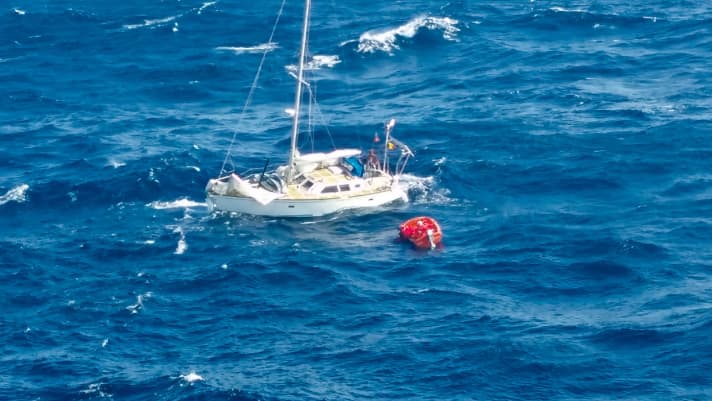
In your opinion, did the sailor behave correctly during the rescue?
That was actually all okay. He couldn't have contributed to the manoeuvre himself. The fact that he didn't do anything was exactly right in this case. But he made it very difficult for us with the lines floating in the water. And he could perhaps have worn the waistcoat over his overall. But it was good that he gave us very clear signs that everyone could understand. And that he had his passport with him - that's crucial! Without a passport, you have huge problems ever getting off the boat again.
"I've seen waves on the North Atlantic that no boat can handle - unless it can capsize"
How did the rescue continue once the sailor was safely in the boat?
That's when it got dangerous again. I tried to drive a duck pond again. But that didn't work out so well because I couldn't accelerate the ship enough - we would have been far too far away. The sea was therefore still very rough when the lifeboat approached our ship. To pick it up again, we lowered a large hook onto a block. It swung 20 kilograms in the air while the boat moved up and down a few metres in the swell. One of the men had to catch the hook and attach it to the boat. This is life-threatening, but fortunately it was successful on the first attempt. The boat was caught by a wave two or three more times and started to swing quite a bit, but fortunately in a longitudinal direction. Otherwise it would have hit the side of the boat. 20 seconds later, everyone was safely on deck.
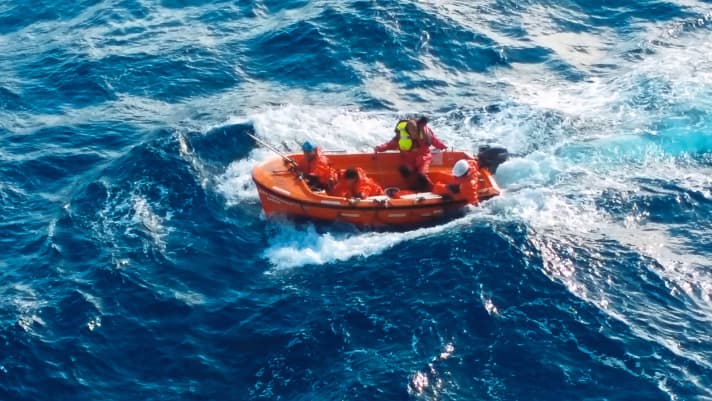
How long did the rescue take in total?
It felt like three days, but in reality it was less than two hours. In that short time, we travelled ten miles to the sailor, did a reconnaissance round, made the boat ready and recovered him. That later earned us a commendation from the US Coast Guard.
How high was the risk for your crew during the operation?
I only risked the whole thing because I still had more than two hours of daylight. I had thought about it beforehand: If something happens now and it gets dark, I won't be able to find the crew again. It was a great adventure for my crew and they celebrated afterwards. They didn't feel at risk either. For me, it felt riskier. It's different when you put yourself in danger than when you send your colleagues. You can risk your own life - but that of others? If something happens, you feel responsible for the rest of your life. I had these thoughts all the time. And I asked myself whether it should have come to this.
Why is that?
I've been a sailor myself since I was a child. During the rescue, the sailor in me scolded the sailor. The severe weather area didn't come as a surprise - I had seen it in the weather forecast a week earlier. The sailor left Halifax and sailed right into this storm without reefing. If you set off single-handed on the Atlantic at the wrong time of year, you know the danger and shouldn't necessarily expect to be rescued. That's my personal assessment. I've seen waves on the North Atlantic that no sailing boat can handle. If they are steep enough, they will overturn a boat. So I have to have one that can capsize!
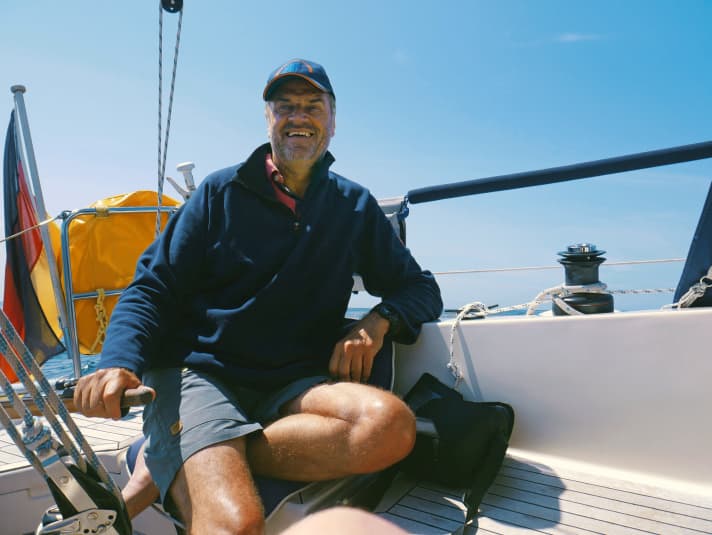
After you rescued the sailor, he travelled to Europe with you. What did he himself say about all of this?
He reported that water had broken into the ship via the lifting keel mechanism. He was unable to repair the leak and after his electric pumps failed, he had to steer by hand. When we picked him up, he had been in this situation for more than two days. He was really exhausted. He said of himself that he had a lot of sailing experience, even on the high seas. But I think he only ever sailed with us. He told us very little about the whole process. We could only assume that the wind took him by surprise and he couldn't manage to reef on his own. After everything on deck had been torn to shreds, he probably just went down to the cabin and worried about his survival. I was really scared for him that first evening.
Why is that?
I only heard very sober sentences from him after the rescue. I explained to him that I couldn't salvage his boat because I didn't even have a crane on board. He was completely unperturbed by the fact that someone would fish it up or it would sink. I wondered how I would feel if my boat sank. I certainly wouldn't be so calm! So I was worried that he might hurt himself when he realised what he had lost. That's why I put a guard outside his door the first night.
How did it all end?
The worry was unnecessary. He later said that he was doing very well financially. The boat was insured, so no major loss for him. We gave him food and clothes and even invited him for a beer. However, in the six days up to Le Havre, he didn't even manage to thank anyone. A big thank you only came in a long letter from his wife four weeks later.
Interview: Ursula Meer

